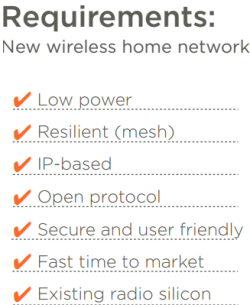
Google, Silicon Labs mesh for ZigBee-like protocol
One sign of the times is the host of industry groups and consortia that have sprung up in recent months and are jockeying to lead the IoT market.
These initiatives include the Qualcomm-led Alljoyn, the Intel-initiated Open Interconnect Consortium, Apple’s HomeKit, and Google’s Thread.
However, the IoT industry’s fragmentation is "somewhat artificial," Silicon Labs CEO Tyson Tuttle told us. Everyone in the industry wants to build its own IoT "ecosystems" and "gateways," and too many people are doing things their own way. But, then, "Who wants five gateways in a home?"
Silicon Labs hopes that the industry will come together at least on the network layer to enable connectivity and interoperability among IoT devices.
ZigBee 3.0?
Google’s Nest-led Thread Group is meeting at its campus in Mountain View, Calif., on Tuesday to unveil Thread’s IP-enabled low-power network, its protocol and software stack that can run on today’s 802.15.4 products (which will be upgraded via software).
Tuttle said the IoT industry badly needs a "low-data-rate, low-power version of WiFi," and Thread plans to deliver it. Silicon Labs is one of founding members of the group, along with ARM and Freescale.
The Silicon Labs software team literally took over the job of "writing the spec" for Thread’s new IP-based mesh networking software stack for the Connected Home, he said. The company contributed by developing the golden stack and software that will be needed for interoperability. The results are being unveiled at the group’s event as a "Thread beta program" for selected customers and ecosystem partners.
Silicon Labs, a leading analog and mixed signal chip vendor, gained in-depth expertise on the low-power 2.4GHz wireless mesh network technology through the 2012 acquisition of the Boston ZigBee chip company Ember. "We do have the industry’s best software team" when it comes to 802.15.4 solutions, Tuttle said.
Thread’s IP-enabled low-power, low-data-rate network layer isn’t the same as that of ZigBee. It is more like "ZigBee 3.0."
However, Thread Group will not wait for this to be discussed and approved by the ZigBee Alliance. Instead, the group will fast track it as a de facto standard and then bring it back to the ZigBee Alliance for approval. "We just think that it will be more efficient that way."
Previously, ZigBee attempted to make its standard "IP-enabled" for the industrial market. Such efforts were mostly driven by utility companies. With too many players getting involved, the alliance made compromises along the way. In the end, Tuttle said, the IP-enabled ZigBee spec has yet to be broadly adopted.
Now with Google’s Nest on its side, along with help from ARM and Freescale, Silicon Labs is confident that the IoT industry will rally behind the new Thread network layer.
Competing groups such as Alljoyn, the Open Interconnect Consortium, Homekit, and even Thread have a recommended set of applications built on their own APIs. But each group could leverage Thread’s proposed IP-based mesh networking software stack for the Connected Home, he said.
ZigBee vs. Bluetooth Low Energy
The 802.15.4-based devices touted by the Thread Group aren’t exactly ZigBee, but they resemble ZigBee functionally.
No smartphones and tablets today come with ZigBee. The absence of ZigBee in such ubiquitous mobile products creates an opening for CSR Mesh technology, which takes advantage of Bluetooth Low Energy.
How is Silicon Labs, or the Thread group as a whole, going to address ZigBee vs. Bluetooth issues?
The solution, in Tuttle’s mind, is straightforward. The first step is to enable every ZigBee network device used at home to talk to smartphones via Bluetooth Low Energy.
He revealed that Silicon Labs is developing a next-generation platform specifically designed to talk to multiple wireless technologies, including ZigBee, Bluetooth Low Energy, and sub-gigahertz networks. This isn’t just a new SoC with different RFs slapped on. "I’m talking about a programmable device platform."
Silicon Labs will integrate RF and software into the company’s broad range of microcontrollers, he said. While Qualcomm and Broadcom, for example, are busy vertically integrating different technology blocks in their IoT SoCs, Silicon Labs’ plan is to add programmable RF/software features horizontally across a wide portfolio of the company’s microcontrollers.
Sure, ZigBee isn’t designed to work in a smartphone, but if today’s 802.15.4 products could be upgraded via software to talk to Bluetooth Low Energy, much of the communication problem on the network level would be mitigated.
Silicon Labs’ host of new programmable products — integrated with multiple RF and software — will come out throughout 2015. The company has internally developed Bluetooth Low Energy expertise, Tuttle said; some of it came from the 2013 acquisition of Energy Micro in Oslo, Norway. Energy Micro was a leader in low-power ARM Cortex-based microcontrollers and radio.
CSR mesh is a "system that isn’t well thought out," Tuttle said. "It’s not standardized yet, and it hasn’t reached the same level of maturity as that of Bluetooth Low Energy or ZigBee."
 If you enjoyed this article, you will like the following ones: don't miss them by subscribing to :
eeNews on Google News
If you enjoyed this article, you will like the following ones: don't miss them by subscribing to :
eeNews on Google News






